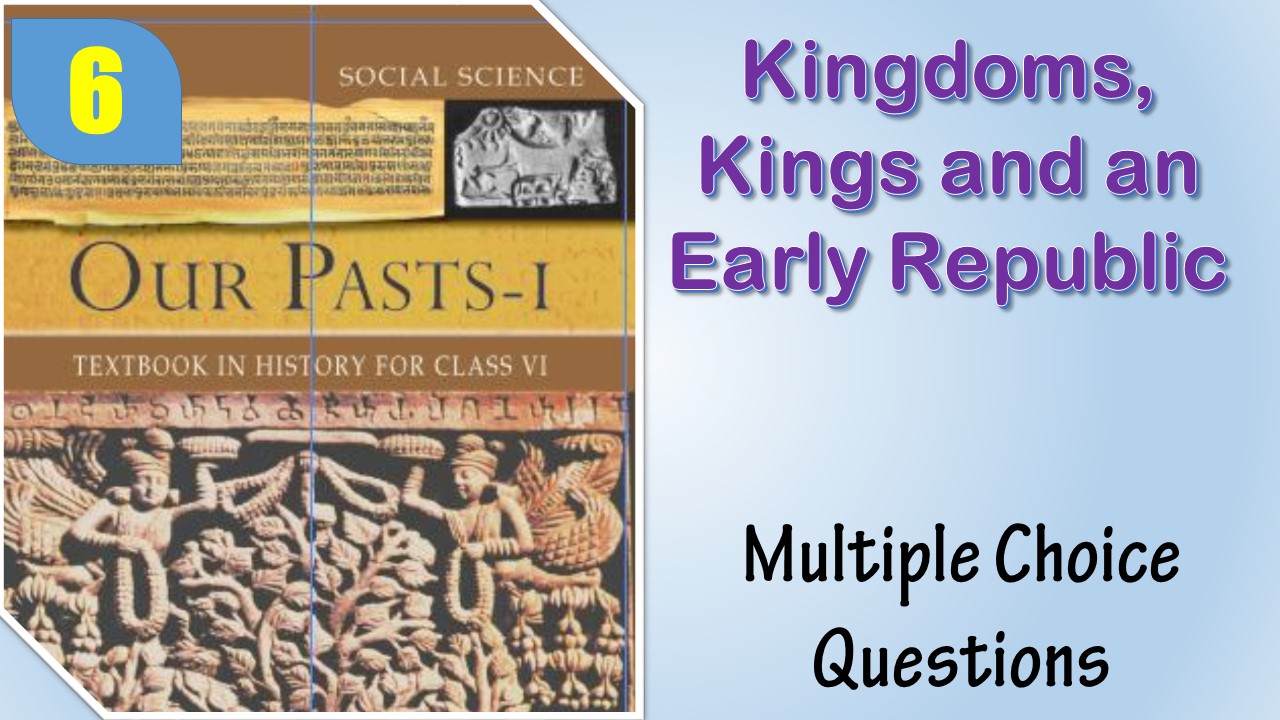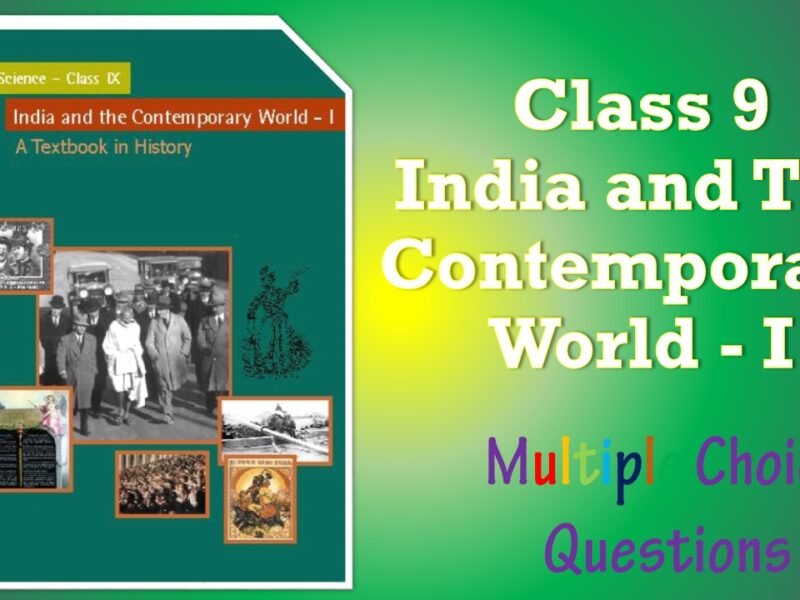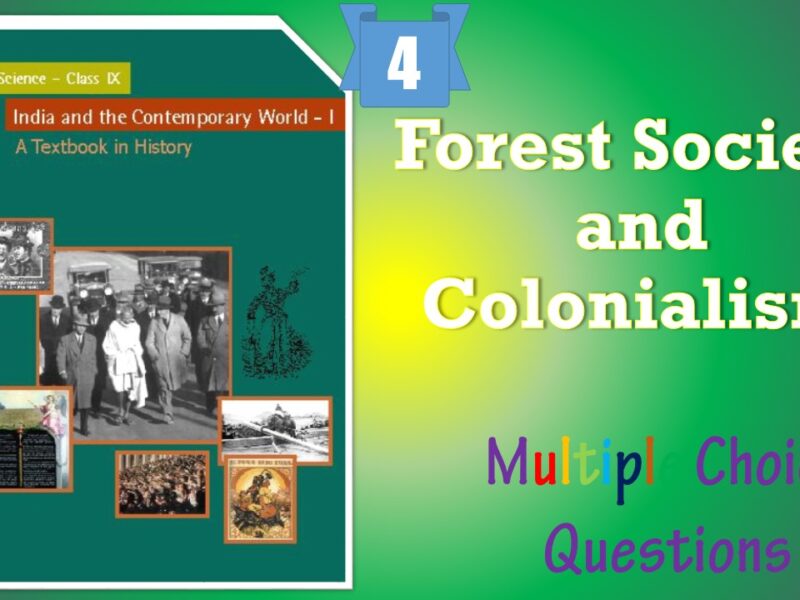Class 6 Social Science History MCQ Kingdoms, Kings and an Early Republic with Answers is Prepared Based on Latest Exam Pattern. Students can solve NCERT Class 6 Social Science History MCQ Kingdoms, Kings and an Early Republic with Answers to know their preparation level.
Students who are searching for NCERT Class 6 Social Science History MCQ Kingdoms, Kings and an Early Republic with Answers are compiled here to get good practice on all fundamentals. Know your preparation level on MCQ Questions for Class 6 Social Science History MCQ Kingdoms, Kings and an Early Republic with Answers. You can also verify your answers from the provided Class 6 Social Science History MCQ Kingdoms, Kings and an Early Republic with Answers. So, ace up your preparation with MCQ of Class 6 Social Science History & NCERT Textbook solutions Examinations.
CBSE Class 6 Social Science History MCQ Kingdoms, Kings and an Early Republic with Answers
Question : According to the Veda, which statement is false?
(a) Brahmins were expected to study the Vedas, perform sacrifices and receive gifts.
(b) Kshatriyas were the rulers. They were expected to fight battles and protect people.
(c) Both Shudras and women were allowed to study the Vedas.
(d) Shudras were last who had to serve the other three groups and could not perform any sacrifice. Later, they were classified as untouchables. The priest said that contact with these was polluting.
Answer : (c) Both Shudras and women were allowed to study the Vedas.Show Answer :
Question : What is true in respect of Athens?
(a) Women of Athens were not considered citizens.
(b) Foreigners, who lived and worked in Athens, did not have rights as citizens.
(c) There were several thousand slaves in Athens who were not treated as citizens.
(d) All above.
Answer : (d) All above.Show Answer :
Question : How much of the produce was collected as tax
(a) one-third part
(b) one-fifth part
(c) one-sixth part
(d) half part
Answer : (c) one-sixth partShow Answer :
Question : Who was son of Bimbisara
(a) Ashoka
(b) Ajatshatru
(c) Nanda
(d) Maurya
Answer : BShow Answer :
Question : Which of the following is not a Mahajanapadas
(a) Magadha
(b) Inamgaon
(c) Avanti
(d) Kamboj
Answer : BShow Answer :
Question : ____ had a large deposits of iron-ore
(a) Malla
(b) Vajji
(c) Magadha
(d) Ujjayini
Answer : CShow Answer :
Question : Amatya means
(a) Purohits
(b) Kings
(c) Ministers
(d) Farmers
Answer : CShow Answer :
Question : Magadha and _________ are examples of monarchical mahajanapadas
(a) Shakyas
(b) Lichchhavis
(c) Vajji
(d) Vatsa
Answer : DShow Answer :
Question : Who was the central figure in the Ashvamedha sacrifice
(a) Ministers
(b) Purohit
(c) King
(d) Soldiers
Answer : CShow Answer :
Question : How did men become rulers around 3,000 years ago?
(a) By choosing rulers by voting
(b) By ashvamedha yajna
(c) None of these
(d) Both (a) and (b)
Answer : BShow Answer :
Question : Why did the rulers collect regular taxes?
(a) For building huge forts
(b) For maintaining big armies
(c) Both (a) and (b)
(d) None of these
Answer : CShow Answer :
Question : A form of government in which the power is held by the people or a group of elected person or an elected chief is called
(a) Autocratic
(b) Oligopoly
(c) Republic
(d) Military
Answer : CShow Answer :
Question : One-sixth of the produce was taken as tax from
(a) farmers
(b) hunter-gatherers
(c) crafts-persons
(d) Traders
Answer : AShow Answer :
Question : Which of the following is not among the four varnas
(a) Shakti
(b) Brahmin
(c) Vaishyas
(d) Kshatriyas
Answer : AShow Answer :
Question : Spices and precious stones came to Magadha from
(a) Taxila
(b) Ujjayini
(c) South India
(d) Punjab
Answer : CShow Answer :
Question : Which among the following is not capital of big cities of that period
(a) Pawa
(b) Champa
(c) Rajgriha
(d) Anga
Answer : DShow Answer :
Question : Who was the founder of Nanda Dynasty
(a) Mahanara Nanda
(b) Mahapadma Nanda
(c) Maha Nanda
(d) Padma Nanda
Answer : BShow Answer :
Question : Painted grey were is
(a) Pottery
(b) Name of an animal
(c) Weapon
(d) Name of a kingdom
Answer : AShow Answer :
Question : How much of the produce was collected as tax
(a) one-third part
(b) one-fifth part
(c) one-sixth part
(d) half part
Answer : CShow Answer :
Question : Chhotanagpur Plateau has been rich in
(a) Iron-ore
(b) Aluminium-ore
(c) Coal-ore
(d) Gold-ore
Answer : AShow Answer :
Question : ____ and its tributaries flows through the kingdom of Magadha
(a) Indus
(b) Yamuna
(c) Tapi
(d) Ganga
Answer : DShow Answer :
Question : Alexander lived in
(a) India
(b) Macedonia
(c) Taxila
(d) West Asia
Answer : BShow Answer :
Question : Who could not participate in the assemblies?
(a) Women
(b) Dasas
(c) Kammakaras
(d) All of these
Answer : DShow Answer :
Question : Who worked as a farmers in the agriculture field
(a) Dass, Landless people, Women
(b) King, Purohit, Women
(c) Dass, Shudras, Vaishyas
(d) Dass, Brahmins, Kshatriyas
Answer : AShow Answer :
Question : Who worked as a farmers in the agriculture field
(a) Dass, Landless people, Women
(b) King, Purohit, Women
(c) Dass, Shudras, Vaishyas
(d) Dass, Brahmins, Kshatriyas
Answer : AShow Answer :
Question : Amatya means
(a) Purohits
(b) Kings
(c) Ministers
(d) Farmers
Answer : CShow Answer :
Question : Who brought gifts for rulers?
(a) Vaishyas
(b) Shudras
(c) Brahmins
(d) None of these
Answer : AShow Answer :
Question : About 2,500 years ago what turned into Mahajanapadas?
(a) Ordinary janapadas
(b) Important janapadas
(c) Both (a) and (b)
(d) None of these
Answer : BShow Answer :
Question : Small states ruled by the tribals were called
(a) Village
(b) Mahajanapadas
(c) Maharuler
(d) Janapadas
Answer : DShow Answer :
Question : Vajji had its capital city at
(a) Raj agriha
(b) Vaishali
(c) Patna
(d) Magadha
Answer : BShow Answer :
Question : Classification of society into four groups on the basis of their occupation is called
(a) Vajja
(b) Vista
(c) Varna
(d) Vedas
Answer : CShow Answer :
Question : Which animal was let loose in Ashvamedha?
(a) Cow
(b) Horse
(c) Elephant
(d) Buffalo
Answer : (b) HorseShow Answer :
Question : Who was a central figure in the rituals?
(a) Brahmins
(b) Women
(c) Janas
(d) King
Answer : (d) KingShow Answer :
Question : Magadha and _________ are examples of monarchical mahajanapadas
(a) Shakyas
(b) Lichchhavis
(c) Vajji
(d) Vatsa
Answer : (d) VatsaShow Answer :
Question : ____________ had a large deposits of iron-ore
(a) Malla
(b) Vajji
(c) Magadha
(d) Ujjayini
Answer : (c) MagadhaShow Answer :
Question : Which among the following is not capital of big cities of that period
(a) Pawa
(b) Champa
(c) Rajgriha
(d) Anga
Answer : (d) AngaShow Answer :
Question : Who was the central figure in the Ashvamedha sacrifice
(a) Ministers
(b) Purohit
(c) King
(d) Soldiers
Answer : (c) KingShow Answer :
Question : Who were poor?
(a) Brahmins
(b) King
(c) Farmers
(d) Traders
Answer : (c) FarmersShow Answer :
Question : Who guarded the horse?
(a) Janas
(b) Raja’s men
(c) Ordinary people
(d) All of these
Answer : BShow Answer :
Question : In what mode were the payments made?
(a) Punch marked coins
(b) Paper notes
(c) Gold coins
(d) Silver coins
Answer : AShow Answer :
Question : Who was the king of Magadha who ruled between 547 to 495 B.C
(a) Bimbisara
(b) Ajatshatru
(c) Nanda
(d) Ahsoka
Answer : AShow Answer :
Question : The ‘ashvamedha’ was the sacrifice of
(a) horse
(b) cow
(c) bull
(d) goat
Answer : AShow Answer :
Question : Who were considered as untouchable in Varna system’?
(a) Brahmins
(b) King
(c) Shudras
(d) Women
Answer : (c) ShudrasShow Answer :
Question : Who were the people who studies the Vedas, performed sacrifices and received gifts?
(a) Brahmins
(b) King
(c) Janas
(d) Merchant
Answer : (a) BrahminsShow Answer :
Question : Which sentence is not true in respect of forts?
(a) Forts were built because people were afraid of attacks from other kings
(b) People were also controlled easily by kings by fortification.
(c) Some kings also wanted to show how rich and powerful they were by building really large, tall and impressive walls around their cities?
(d) All are true.
Answer : (d) All are true.Show Answer :
Question : Which sentence is not true in respect of the later Vedic books?
(a) In north India, many books were composed in the area drained by the Ganga and the Yamuna.
(b) These were composed before the Rigveda.
(c) These books described how rituals were to be performed and rules about society.
(d) These books were composed by priests.
Answer : (b) These were composed before the Rigveda.Show Answer :
Question : Which sentence is not true in respect of Pottery found in Mahajanapadas?
(a) These made earthen pots.
(b) Some of them were grey in colour, other were red.
(c) One special type of pottery found at these sites is known a Painted Grey Ware.
(d) These grey pots had painted designs, usually simple lines in geometric patterns.
(e) All are true.
Answer : (e) All are true.Show Answer :
Question : Classification of society into four groups on the basis of their occupation is called
(a) Vajja
(b) Vista
(c) Varna
(d) Vedas
Answer : (c) VarnaShow Answer :
Question : _________________ means unquestioned control over an area in which the royal horse move uninterrupted
(a) Shermedha
(b) Ashvamedha
(c) Singhmedha
(d) Shatriyas
Answer : (b) AshvamedhaShow Answer :
Question : Who was the founder of Nanda Dynasty
(a) Mahanara Nanda
(b) Mahapadma Nanda
(c) Maha Nanda
(d) Padma Nanda
Answer : (b) Mahapadma NandaShow Answer :
Question : The farmers gave one-sixth of their produce to the king which was called
(a) Bhaga
(b) Part
(c) Hissa
(d) Bhora
Answer : (a) BhagaShow Answer :
Question : Who worked as a farmers in the agriculture field
(a) Dass, Landless people, Women
(b) King, Purohit, Women
(c) Dass, Shudras, Vaishyas
(d) Dass, Brahmins, Kshatriyas
Answer : (a) Dass, Landless people, WomenShow Answer :
Fill in the blanks
Question : Shudras and ……………………… were not allowed to study the Vedas.
Answer : womenShow Answer :
Question : Shudras were later classified as ……………………… .
Answer : untouchablesShow Answer :
Question : ……………………… was not grown earlier in this settlement.
Answer : Sugar caneShow Answer :
Question : Earthen pots were ……………………… and ……………………… in colour.
Answer : grey and redShow Answer :
Question : Tax collected from farmers was known as ……………………… .
Answer : ‘bhaga’Show Answer :
Question : ……………………… was capital of Magadha for several years. Later the capital was shifted to ………………………
Answer : Rajgir, PataliputraShow Answer :
Question : ……………………… and ……………………… of Athens were not considered citizens.
Answer : Slaves, womenShow Answer :
Question : All the men over the age of ……………………… years were recognized as full citizens of Athens.
Answer : 30Show Answer :
Question : Digha Nikaya is a famous ……………………… .
Answer : Buddhist bookShow Answer :
Question : First democracy began at ……………………… .
Answer : AthensShow Answer :



